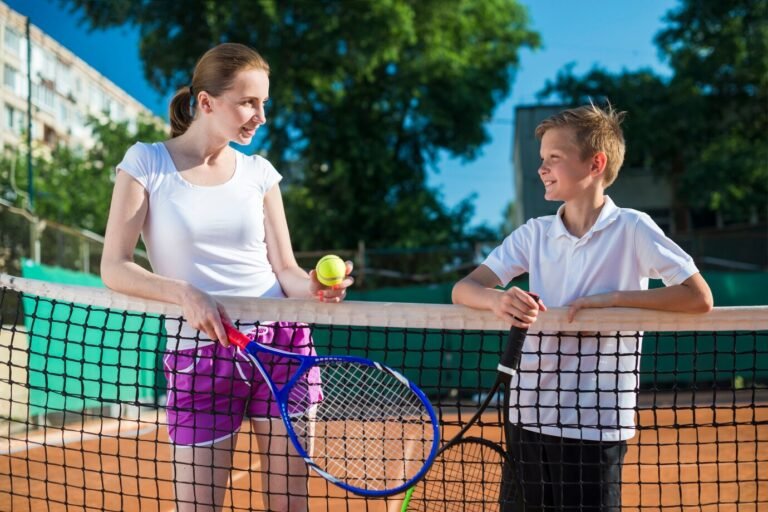Introduction
Tennis lessons is a thrilling and rewarding sport that combines physical fitness, strategy, and mental focus. Whether you’re a beginner picking up a racket for the first time or an intermediate player looking to refine your skills, structured tennis lessons can significantly improve your game. Learning proper techniques, footwork, and match strategies will not only enhance your performance but also make the game more enjoyable. In this article, we’ll explore key aspects of tennis lessons, from fundamental strokes to advanced tactics, helping you develop a well-rounded understanding of the sport.
1. The Fundamentals of Tennis: Building a Strong Foundation
Before diving into advanced techniques, every player must master the basics. Tennis lessons typically start with grip techniques, stance, and posture. A proper grip ensures better control and power, whether using the Eastern, Continental, or Western grip for different strokes. Footwork is another essential component—learning to move efficiently on the court helps in positioning yourself for optimal shots. Coaches also emphasize the ready position, where players stay on their toes, knees slightly bent, and racket prepared for quick reactions. Without a solid foundation, advanced skills become much harder to develop, making these early lessons crucial for long-term success.
2. Perfecting Your Strokes: Forehand, Backhand, and Volleys
Once the basics are in place, tennis lessons shift focus to core strokes. The forehand is often the most natural and powerful shot, requiring proper swing mechanics and follow-through. The backhand, whether single or double-handed, demands precision and wrist stability. Volleys, used when close to the net, require quick reflexes and a compact swing to control the ball effectively. Coaches break down each stroke into smaller components, ensuring players understand weight transfer, racket angle, and contact point. Drills and repetition help ingrain muscle memory, allowing players to execute these shots instinctively during matches.
3. Serving and Return Techniques: Gaining the Competitive Edge
The serve is one of the most critical aspects of tennis, acting as the starting point of every rally. Lessons cover different types of serves—flat, slice, and kick—each with unique advantages. Proper ball toss, body rotation, and follow-through determine the serve’s power and accuracy. Equally important is the return of serve, where players must anticipate the ball’s speed and spin to neutralize the opponent’s advantage. Coaches train players to read serves early, adjust footwork, and choose between aggressive or defensive returns based on the situation. Mastering these skills can turn a player from reactive to dominant in service games.
4. Footwork and Court Movement: Speed and Efficiency
Tennis is as much about movement as it is about hitting the ball. Efficient footwork allows players to reach shots quickly while maintaining balance for powerful returns. Lessons incorporate drills like ladder exercises, side shuffles, and split-step techniques to improve agility. Players also learn how to position themselves based on the opponent’s shot—moving forward for offensive plays or recovering backward for defensive ones. Understanding court geometry—such as angles, depth, and width—helps in covering the court effectively, reducing unforced errors and conserving energy during long rallies.
5. Strategy and Mental Toughness: Playing Smarter, Not Just Harder
Beyond physical skills, tennis requires strategic thinking and mental resilience. Tennis Lessons often include match simulations where players practice point construction, shot selection, and adapting to opponents’ weaknesses. Coaches teach when to play aggressively versus defensively, how to exploit an opponent’s backhand, or when to approach the net. Mental toughness is also emphasized—staying focused under pressure, managing frustration, and maintaining confidence during tight matches. Visualization techniques and breathing exercises are often incorporated to help players stay calm and composed in high-stakes situations.
6. Doubles Tactics: Teamwork and Communication
Doubles tennis introduces a new layer of strategy, requiring coordination with a partner. Lessons focus on positioning (such as the “one-up, one-back” formation), effective communication, and synchronized movement. Players learn how to cover the court efficiently, poach at the net, and execute strategic serves like the “I-formation” to confuse opponents. Doubles also emphasizes quick reflexes at the net, with drills designed to improve reaction time for volleys and smashes. Understanding each player’s role and maintaining constant communication can turn a good doubles team into a dominant one.
Conclusion
Tennis lessons offer a structured pathway to improving every facet of your game, from fundamental strokes to advanced strategies. By focusing on technique, movement, and mental preparation, players can elevate their performance and enjoy the sport at a deeper level. Whether you’re training for competition or playing recreationally, consistent practice and professional guidance will help you unlock your full potential on the court. So grab your racket, find a good coach, and start your journey toward becoming a more skilled and confident tennis player!

